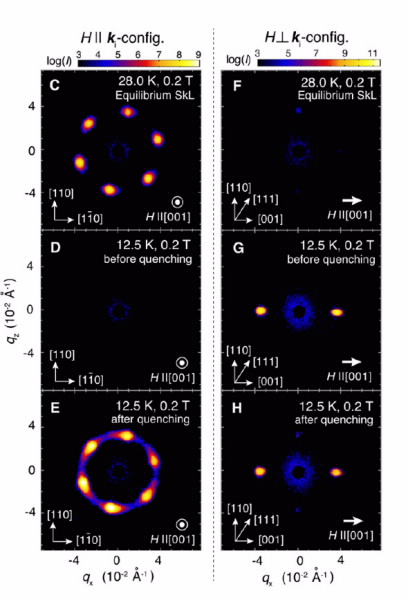 |
| After forming a stable, triangular lattice of skyrmions, RIKEN researchers used an external magnetic field to rearrange the lattice into a square pattern © 2017 Yoichi Nii |
Measurements at the Australian Centre for Neutron Scattering have helped clarify the arrangement of magnetic vortices, known as skyrmions, in manganese silicide (MnSi).
A skyrmion is the smallest possible change in a uniform magnet: a point-like region of reversed magnetisation, surrounded by a whirling twist of spins.
The magnetic configuration is attracting attention as a potential data carrier in next-generation memory devices.
A group of researchers at the RIKEN Center for Emergent Matter Science in Japan have discovered that a magnetic field can be used to switch a group of skyrmions back and forth between two different lattice arrangements, demonstrating the kind of control needed for advanced memory devices.
The study has been published in Science Advances.
The atoms in certain materials carry their own intrinsic magnetism, with each atom acting like a bar magnet. When these miniature magnets are swept into tiny swirling patterns, they collectively form skyrmions which behave as discrete particles.
It only forms in magnets in which the interaction of spins prefer a magnetic structure with chiral symmetry, such as twist that is either left or right-handed.
Being circular, skyrmions typically pack together in a triangular lattice.
Taro Nakajima and Hiroshi Oike of RIKEN and colleagues studied how this skyrmion lattice can be manipulated in manganese silicide.
Generally, skyrmion lattices appear in this material only within a narrow range of temperatures and magnetic fields. “That makes the lattices too fragile to rearrange,” said Nakajima.
The team investigated a more robust skyrmion lattice by applying electrical pulses to the material at 12.5 kelvin (K) and a magnetic field of 0.2 tesla (T).
The pulses rapidly heated the material, causing skyrmions to form in a window of stability between 27 and 29 K.
The sample quickly cooled, locking the skyrmions into a triangular lattice that were stable over a much wider range of temperatures and magnetic fields.
The researchers then cooled the sample to 1.5 K and used small angle neutron scattering (SANS) on the QUOKKA instrument to understand how the skyrmion lattice changed under different magnetic fields.
At magnetic fields below 0.1 T, the lattice re-arranged into a square pattern which was stable only within a relatively confined range of very low temperatures and magnetic fields. Raising the field to 0.2 T resurrected the triangular lattice.
 |
| SANS measurements on equilibrium magnetic phases and quenched SkL state under magnetic field of 0.2 T |
“On QUOKKA it was possible to measure changes to the skyrmion lattice in situ when an electric current was applied under different magnetic fields,” said instrument scientist Dr Elliot Gilbert, and co-author on the publication.
Although SANS does not see the particle-like properties of skyrmions directly, the patterns can be interpreted to provide information on the packing of the particles.
The researchers suggest that these lattice transitions are influenced by unevenness, or anisotropy, in the underlying magnetism of the manganese atoms in the material.
At low magnetic fields and temperatures, this anisotropy allows the skyrmions to partially overlap, moving closer together to adopt a square lattice arrangement.
This effect could well occur in other materials, according to the research team.
“Our experiments revealed that the skyrmions do indeed have a particle nature in bulk crystals,” says Nakajima.
“These are expected to be applicable for future magnetic memory devices in which each skyrmion particle behaves as an information carrier.”
http://advances.sciencemag.org/content/3/6/e1602562
Read more on the RIKEN website
Published: 21/06/2017


